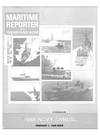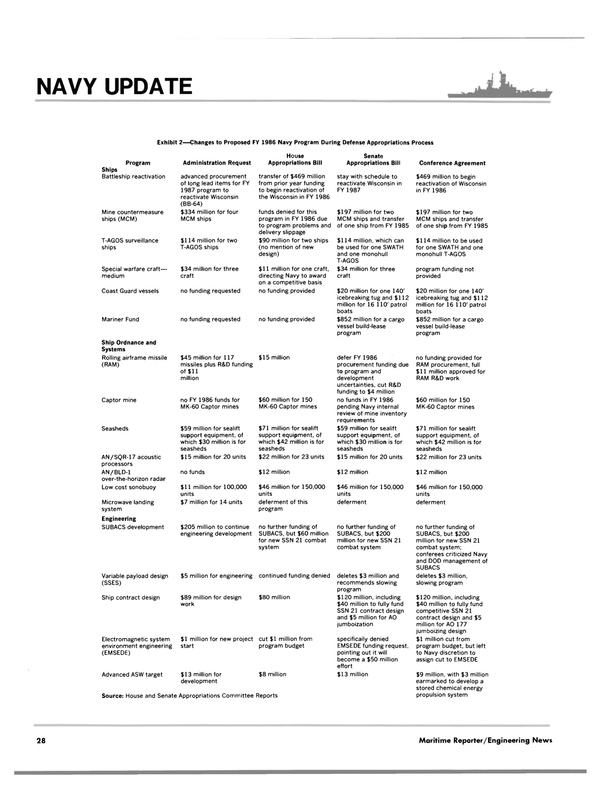
UPDATE ON FY 1986 NAVY PROGRAMS
On 19 December Congress passed a continuing resolution providing defense program appropriations for FY 1986. It provides total obligational authority of $281 billion for defense programs. The Administration had requested $304 billion and last year's defense appropriation was $278 billion.
Navy Funding Navy has received obligational authority totalling $95.6 billion—or 34 percent of the defense dollars.
Last year Navy received obligational authority totalling $93.5 billion.
Exhibit I summarizes FY 1986 legislative action related to key Navy programs.
Gramm-Rudman The Balanced Budget and Emergency Deficit Control Act of 1985 (Gramm-Rudman) signed by the President on 12 December keeps the FY 1986 budget in suspense. Under the Gramm-Rudman law a complicated mechanism has been adopted to reduce future government spending deficits. The law sets a deficit target for each of the next six years.
Budget cuts are automatically mandated in any year where the deficit target will be exceeded. These cuts will be across the board unless the President and Congress agree to a deficit reduction plan.
The House Armed Services Committee recently estimated that the Gramm-Rudman law will require cuts of $10.3-13.3 billion in FY 1986 defense spending authority. Navy funding for operations and procurement programs will obviously be affected by these reductions.
The constitutionality of the Gramm-Rudman law is now being argued in federal court. Meanwhile, as prescribed by the law, the Office of Management and Budget (OMB) and the Congressional Budget Office (CBO) are preparing revised estimates of the FY 1986 deficit. In late January the President is to propose his plan for meeting the FY 1986 Gramm-Rudman deficit target.
Planning in DOD is affected by the uncertainty created by this funding suspense.
Procurement and Engineering/Design Congress made a number of changes to the FY 1986 Navy ship procurement program. Funds were provided to begin reactivation of the battleship Wisconsin this year, in- stead of in FY 1987. The MCM program was partially deferred due to technical problems and program slippage. A SWATH design has been approved for the T-AGOS program.
The Coast Guard has received funding authority to build an icebreaking tug and 16 patrol boats.
And a Mariner Fund to build and subsequently lease cargo ships was tentatively funded—subject to authorizing legislation.
In weapons and systems procurement, Congress denied funding of the rolling airframe missile. Funds were provided to buy 150 MK-60 Captor mines. The funding for seasheds was increased $12 million from the $30-million budget request.
Important changes were made in engineering and design programs.
Funds for the SUBACS program were denied due to "severe technical and management problems (which) have significantly increased costs, delayed schedules, and degraded planned system capability." IBM is the prime contractor in the SUBACS program. In place of the $205 million requested by Navy for further SUBACS development, Congress provided $200 million for a new SSN-21 combat system program and strongly criticized Navy and DOD's management of the SUBACS program.
These and other FY 1986 program changes are summarized in Exhibit 2.
Congress appropriated $6.1 billion this year for ship maintenance and modernization. This is the full amount requested by the Administration.
It will provide funding for 35 active fleet ship overhauls, six naval reserve ship overhauls and 142 short term ship maintenance jobs.
Exhibit 3 lists the active and reserve fleet overhauls scheduled for commercial yards in FY 1986. The dollars shown are Navy's estimate of the cost to complete each job.
The Congress also issued a number of policy directions concerning homeport policy, yard certification and number of ships to include in this year's public/private yard competition.
Future Navy Programs On 3 February the President will send his FY 1987 budget request to Congress. It is expected to call for a 3 percent real increase in defense spending next year.
The deficit targets set by Gramm- Rudman, and more generally the growing concern over continued deficit spending, are likely to impact future Navy programs. Look for elimination and stretch out of marginal procurement programs—such as support ships. Navy will likely reduce operational tempo in an effort to save money, with ships spending less time at sea.
Read UPDATE ON FY 1986 NAVY PROGRAMS in Pdf, Flash or Html5 edition of February 1986 Maritime Reporter
Other stories from February 1986 issue
Content
- Bremer Vulkan To Build 2 Bremen Class Frigates For Federal German Navy page: 5
- Study To Evaluate Tanker-Based FPSO For Gulf Of Mexico page: 5
- Marinette Marine Delivers Last Of 52 Workboats A Year Ahead Of Schedule page: 6
- Boston Fuel Acquire Assets Of Boston Towboat Co. page: 7
- M.A.N.-GHH To Build Floating Drydock For Polish Shipyard page: 7
- British Broker Reports Surge In Tanker Rates, Fall In Laid-Up Tonnage page: 7
- Robert E. Derecktor Launches First Of Two Staten Island Ferries page: 8
- Beth-Sparrows Point Yard Installs $1.1-Million Intermediate Gate For Building/Vessel Servicing Basin page: 8
- New Names Announced For Wartsila Diesel Units page: 9
- HIAB-FOCO Delivers Two Service Cranes To North Sea Oil Project page: 9
- Bath Iron Works Launches Its First Aegis Cruiser page: 10
- Water Jetting System To Install Steel Pilings Developed By Navy page: 11
- USCG And ASNE Flagship Section Sponsor Patrol Boat Symposium page: 12
- Webber Appointed Vice Admiral And U.S. Navy's Chief Engineer page: 12
- Automatic Power Offers 20-Page Color Brochure On Marine Signal Systems page: 12
- Captain Hjelde Named VP And GM At Barber page: 13
- TeleSystems MCS-9100 Receives Japanese Type Acceptance page: 13
- IS IT TIME TO TAKE THE PUBLIC SHIPYARDS PRIVATE? page: 16
- UPDATE ON FY 1986 NAVY PROGRAMS page: 26
- Navy Contracts Totaling $629.2 Million Awarded To Bath And Ingalls Yards page: 30
- Peterson Builders Delivers ARS-51, Grasp, To Navy page: 31
- 1986 Apelco Full-Color Product Catalog Available page: 34
- Carnegie Hero Medals Awarded Posthumously To Fournier, Govoni page: 34
- Coast Guard And Navy To Hold Joint Fire Research Program page: 35
- Peterson Builders Receives Navy Certification Of Metal Spray Facility page: 35
- Key Appointments At Oerlikon page: 36
- NICOR Consolidates Administrative Functions Of 2 Marine Subsidiaries page: 36
- BP Offers Free 32-Page Brochure On World Energy page: 37
- ASEA Names Jon Turley Manager Marine Offshore page: 37
- New One-Stop Shopping Sensors And Controls Catalog From Transamerica Delaval page: 38
- Marine Machinery Association To Sponsor Navy/Industry Panel Discussions On Feb. 26 page: 38
- The New 710G Series Diesel Engines From General Motors Electro-Motive Division page: 40
- Todd Ceases Operations At New Orleans Division page: 41
- Marine Travelift Introduces New Floating Boat Hoist Design page: 41
- Puroflow Filters To Protect Sperry Computers page: 42
- Texas Instruments Offers New GPS Software page: 43
- Aegis Missle Cruiser Valley Forge Commissioned At Ingalls Yard page: 44
- New Yard Opens In Port of Altamira page: 47
- Jacques Cousteau Receives Testimonial Plaque From Carrier Transicold Employees page: 47
- Vecom Takes Over Marine Division Of Houseman page: 48
- Caterpillar Offers Literature On New Marine Diesel Propulsion System Products And Support Programs page: 49
- New Teleflex Remote Valve Actuators Are Designed To Eliminate Problems And Cut Costs page: 52
- Dr. A.C. Antoniou Joins ASRY Production Team page: 53
- Dillingham Offers Free Full-Color Brochure On Ship Repair Facilities page: 53
- Hempel Introduces 'Damp Steel' Primer page: 54
- Reco Crane Promotes Hardin—Literature Offered page: 60
- Metropolitan Offers New Vanstone Flanged Fittings page: 60
- Meyer Retires As Deputy Commander At NAVSEA page: 60
- American Appoints Monaco New Cordage Engineer page: 61


